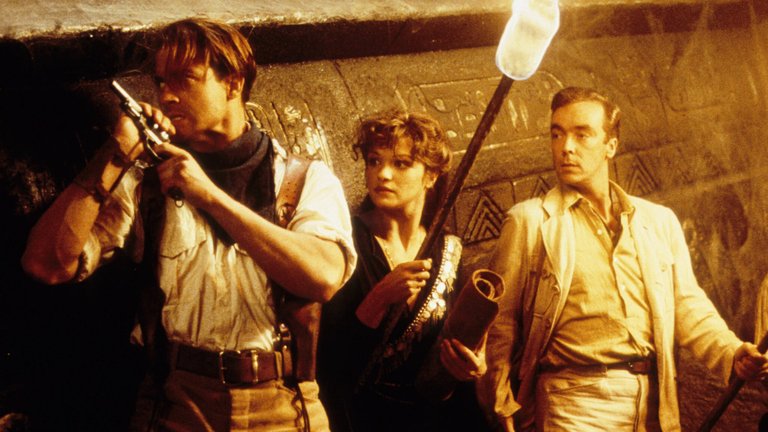Retro Film Review: The Mummy (1999)

World has changed a lot in the past seven decades. What used to scare people and make things like economic depression and encroaching world war seem harmless in comparison is now supposed to be family-friendly entertainment. At least this is the impression given by the way Hollywood remade The Mummy, the classic 1932 horror film by Karl Freund. The new version, directed by Stephen Sommers in 1999, was a commercially successful combination of action, period adventure and comedy.
The plot starts in Egypt around 1100 BC. The high priest Imhotep (played by Arnold Vosloo) made the mistake of starting a relationship with Anck-Su-Namun (played by Patricia Velázquez), a beautiful woman who just happened to be the concubine of Pharaoh Seti (played by Aharon Ipale). The lovers, when discovered, kill the Pharaoh, and Imhotep is going to pay a terrible price for the unimaginable crime of killing a living god. He is mummified alive and struck with a curse so terrible that a person, once released from it, could become immensely powerful. Millennia later, in the 1920s Egypt, the clumsy British librarian Evelyn Carnahan (played by Rachel Weisz) meets Rick O'Connell (played by Brendan Fraser), an American adventurer and former soldier of the French Foreign Legion. O'Connell is one of the rare men who managed to find Hamunaptra, the legendary City of the Dead rumoured to have immense treasure in its ruins. Evelyn and her jovial brother Jonathan (played by John Hannah) join forces with Rick and head towards Hamunaptra. They discover a rival expedition led by Beni (played by Kevin J. O'Connor), Rick's former comrade. When the two expeditions finally reach Hamunaptra, they discover Imhotep's mummy and accidentally revive it. The ancient priest, who has gained great magical powers, wants to rule the world and use Evelyn for the ritual designed to revive Anck-Su-Namun.
Sommers shouldn't be praised for this film, but he was fair to the audience - he never tried to make The Mummy look more ambitious or more serious than it actually was. This film was supposed to be light summer entertainment, and this is exactly what Sommers delivered. Any attempt to compare the 1999 and 1932 versions is as sensible as the comparison between Whale's Frankenstein and Mel Brooks' Frankenstein Junior. Sommers' film is fast-paced, and the audience doesn't have much time to catch details like occasionally unconvincing special effects, major historical inaccuracies, bad jokes or a couple of unnecessary characters.
The plot is very simple, filled with cardboard characters and predictable twists. But few people would care, being overwhelmed with the sheer quantity of action scenes. Many of those scenes are quite spectacular, and some are humorous. Some viewers might object because of too much violence for a family-oriented film or too revealing a costume worn by Patricia Velázquez in the opening scenes. The acting leaves much to be desired - Brendan Fraser and John Hannah are, for example, very capable actors, but they simply can't breathe life into their one-dimensional characters. Rachel Weisz, on the other hand, is very effective in the role that parodies 1930s clichés about female protagonists. Kevin J. O'Connor, however, leaves the best impression in the overblown role of this film's second-tier villain. An equal impression is left by Jerry Goldsmith's musical score, in many ways more memorable than the film itself.
Unlike its cult predecessor, the new version of The Mummy (just like its inevitable sequel) won't be remembered in future decades. But for most of those who watch this film, its two hours is going to be time well-spent.
(Note: The text in its original form was posted in Usenet newsgroup rec.arts.films.reviews on July 9th 2004)
Blog in Croatian https://draxblog.com
Blog in English https://draxreview.wordpress.com/
Rising Star game: https://www.risingstargame.com?referrer=drax
BTC donations: 1EWxiMiP6iiG9rger3NuUSd6HByaxQWafG
ETH donations: 0xB305F144323b99e6f8b1d66f5D7DE78B498C32A7
